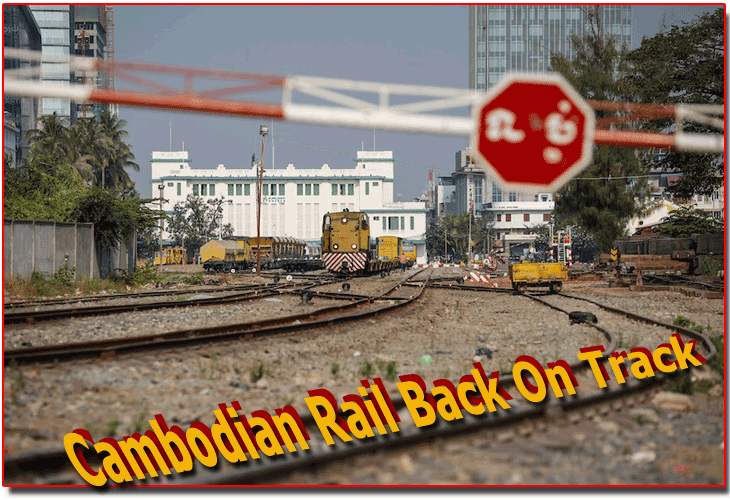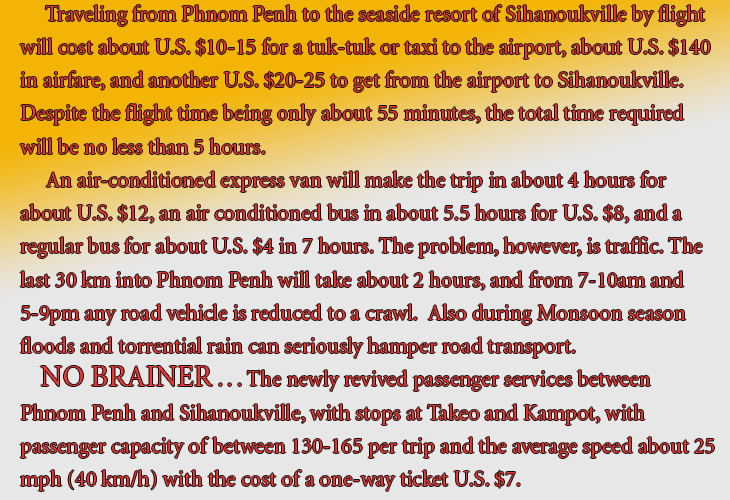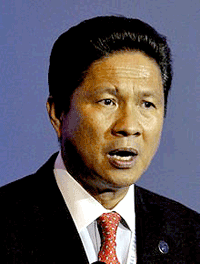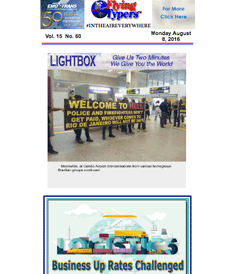
Cambodia
may not be the fastest developing Asian state, but it
sure is the fastest changing one.
Frequent visitors to the
Kingdom of Wonders will note—even when returning
after a few weeks of absence—new high rises, new
brand stores, and an abundance of change at least in
those parts of the country frequently visited by “barang,”
as western foreigners are dubbed in Khmer.
Do not confuse the Khmer
“barang” with the Thai word “farang,”
which essentially means the same thing; however, in
Khmer the term “barang” also has a slightly
negative connotation (in the sense of “rich and
ignorant”) and Khmer people do not take kindly
to being confused or even compared with Thais.
Cambodian development
is still hampered by the oozing wounds afflicted by
the Khmer Rouge regime in power from 1975 to 1979.
In fact, after the Khmer
Rouge Cambodia could be compared to postwar Germany,
just that there was no Marshall plan to help the Cambodian
people back on their feet. All the more impressive is
what the Cambodian people and the Cambodian state—political
judgments left aside here—have achieved. Much
of it has been trial and error, and the average Cambodian
still has to make do with incomes of U.S.$80 or less
a month with social security or medical care largely
uncovered. Nevertheless, or probably even because of
those adversary factors, Cambodia has opened up with
garment production, spices (such as the world famous
Kampot pepper), and the tourism industry accounting
for as much as 43 percent of the national income.
While the boom in Cambodia’s
air transport sector is well known—as recently reported by FT—the changes taking place at Cambodia’s
Royal Railways have been largely overlooked by most
people not living in Cambodia.
Cambodia’s present
380 miles (612 km) of 3 ft., 3 3⁄8 in. (1 meter)-gauge
rail network goes back to the colonial times, when it
was a part of French Indochina and consisted of two
lines.
Lack of maintenance, funds,
and damage during the Vietnam War and the Khmer Rouge
regime forced a total suspension of all services in
2009.
That has changed, as Cambodia’s
booming development necessitated reliable transport
capabilities both in the passenger and freight sector.

As for passenger services,
air transport is too expensive for the average Cambodian,
especially considering the time required to travel to
the departure airport and from the arrival airport to
your destination takes longer than taking a bus or express
van.
Traveling from Phnom Penh
to the seaside resort of Sihanoukville by flight will
cost about U.S. $10-15 for a tuk-tuk or taxi to the
airport, about U.S. $140 in airfare, and another U.S.
$20-25 to get from the airport to Sihanoukville. Despite
the flight time being only about 55 minutes, the total
time required will be no less than 5 hours. An air-conditioned
express van will make the trip in about 4 hours for
about U.S. $12, an air conditioned bus in about 5.5
hours for U.S. $8, and a regular bus for about U.S.
$4 in 7 hours.
The problem, however,
is traffic. The last 30 km into Phnom Penh will take
about 2 hours, and from 7-10am and 5-9pm any road vehicle
is reduced to a crawl.
Also, floods during the
monsoon season and torrential rain can seriously hamper
road transport.
 Cambodia’s
Ministry for Public Works and Transport (MPWT) under
the leadership of H.E. Samdech Sun Chanthol (left) has
revived the rail transport sector with assistance provided
by the Asian Development Bank, AusAID, and the Australian
company Toll Holdings, which from 2009 until 2014 held
a 55 percent stake in Cambodia’s Royal Railways. Cambodia’s
Ministry for Public Works and Transport (MPWT) under
the leadership of H.E. Samdech Sun Chanthol (left) has
revived the rail transport sector with assistance provided
by the Asian Development Bank, AusAID, and the Australian
company Toll Holdings, which from 2009 until 2014 held
a 55 percent stake in Cambodia’s Royal Railways.
A new 73 mi. (115 km)
missing link between Phnom Penh and Touk Meas was completed
in October 2010 and the southern line (unusable since
late 2008 after the worsening condition of the tracks
caused frequent derailments) reopened for freight traffic—mainly
coal and fuel trains as well as container traffic from
Cambodia’s only deep-water port, Sihanoukville,
to Phnom Penh in January 2013 and for passenger traffic
just in time for the Khmer New Year on April 9th, 2016,
after a 14-year downtime.
Also, the Western line
connecting to the Thai railway network is under reconstruction
with a 4 mi. (6.5 km) gap between the border point in
Poipet and Sisophon to be closed by the end of July
2016, and there are plans for a rail connection between
Phnom Penh and Saigon (Ho Chi Minh City) that would
provide a seamless rail link between Singapore and Kunming
in China.
Additionally the Cambodian
MPWT has partnered with China Railway Group to build
a third line of 252 mi. (405 km) in the north-southern
direction across Cambodia to support transport of steel,
sea containers, coal, and fuel and ease road congestion
and damage.
The newly revived passenger
services between Phnom Penh and Sihanoukville, with
stops at Takeo and Kampot, were very well received according
to a press statement Royal Railways CEO John Guiry made
to the Phnom Penh Post.
Passenger capacity is
between 130-165 per trip and the average speed about
25 mph (40 km/h) with the cost of a one-way ticket U.S.
$7.
Royal Railways plans to
rent out carriages for events and conferences because
of plentifold tourist demand.
During recent Thai-Cambodian
consultations that took place at the end of 2015, it
was agreed to open two new international checkpoints
in the Cambodian border province of Banteay Meanchey
as well as developing jointly operated Special Economic
Zones along the Banteay Meanchey-Sa Keo (KH) and Koh
Kong-Trat (TH) borders. These SEC’s will provide
further jobs, tax revenue, and investment by international
companies in both Thailand and Cambodia.
Probably the only downside
of this development is that sooner rather than later
the so-called “bamboo trains” or “Norries”
in Battambang province will perish with the revival
of the track system. “Norries”
are platforms made from bamboo fitted on leftover rail
wheels and powered by small gas engines, chugging along
the old tracks with whatever merchandise or passenger
is to be transported for stretches up to 25 mi. (40
km) on an on-demand basis.
In addition to the more
reliable, economic, faster, and scheduled cargo links
the newly revived Cambodian rail system is going to
provide, the ease on the road system should account
for considerable savings as overloaded trucks, fatigued
drivers, and hardly roadworthy trucks account for considerable
damages including collapse of bridges, a gruesome death
toll in road accidents, and considerable pilferage.
Peter Harcourt
|





